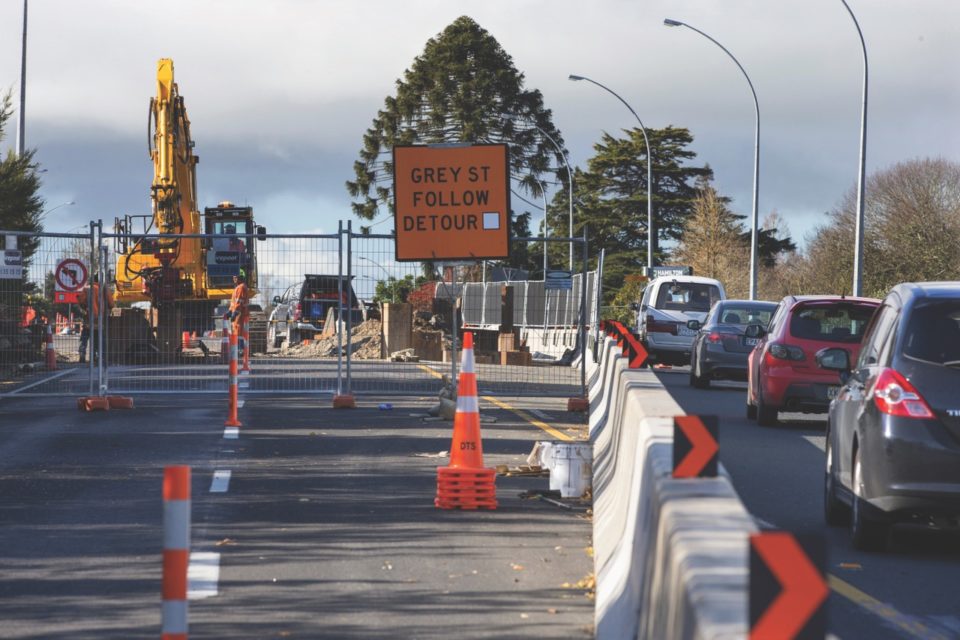There has been a lot of publicity recently about the state of our roads, particularly the national highway network. By CCNZ chief executive Alan Pollard.
Our Technical Manager, Stacy Goldsworthy, was interviewed by TV3’s AM Show prior to Christmas; I was interviewed by Rachel Smalley for the First Light show on Today FM; and we published a statement across the Stuff Network (including the Dominion Post and Christchurch Press) over the holiday break calling for patience and understanding from drivers at road work sites, particularly those with traffic management in place.
There have been many stories about damage to vehicles from potholes and deteriorating road surfaces, as well as catastrophic damage to our network from severe weather events. While the cause is long-standing underinvestment in maintenance from central government, we are increasingly also hearing of cases where our traffic controllers and people working to repair these very issues are facing misguided anger, abuse and even violence from members of the public.
It is disappointing that traffic management staff, road maintenance workers and others working in the road corridor need to resort to wearing body cameras to protect themselves from abuse, threats, and assault, which I have been informed are becoming the greatest risk on many road work sites.
It is also disappointing to witness vehicles speeding through work sites. I have heard of traffic controllers injured by flying rocks, and we have seen the worst impact of this with lives lost on road work sites due to drivers ignoring temporary speed restrictions.
Of course, we can understand people wanting to get to their destinations as quickly and efficiently as possible, but workers need to be able to complete their tasks and return safely to their families each day.
Now a year into my role, I have a whole new appreciation of the reasons behind traffic management and speed restrictions at road work sites, and a whole new level of respect for those who work on the sites.
But driving around over the holiday period and observing other drivers at road work sites, I wondered just how many drivers understand the logic and reasons behind how a road work site operates.
As contractors, you all know road work sites are set up to primarily achieve three key purposes: to provide an environment within which the road works can be done safely and efficiently; to ensure the safety of our road workers; and to minimise disruption to travellers.
And, you all know reduced speed limits at work sites are there because increased speed not only puts drivers and workers at risk. It also damages freshly-laid road surfaces, leading to premature remedial work (resulting in another traffic control site and a fresh set of delays).
I wonder how much of this understanding is shared by the public?
We shouldn’t have to explain to the public that the person on the other side of the cones or the stop-go sign is working for the benefit of the public and has a family to go home to, but we seem to be in that situation, whether the work site is on a state highway or in a residential area.
I think contractors and clients are very good at saying “what” is going to be done, but I’m not so sure the same applies to “why” things are being done, or why they are being done in a certain way, at a certain time.
This goes to the heart of our social licence to operate. In essence, the ability of a project, an organisation, or an industry to carry out its business because the public or community has confidence it will behave legitimately, with accountability and in a socially and environmentally responsible way.
Clear and effective communication is a key part of building this understanding.
So, what are some of the complaints I have heard from road travellers?
“There were 30km/hr signs out, but no one was working on site; we were held up for 20 minutes while traffic came through from the other direction, but when it came to our turn, they only let a few cars through; there was no warning we were about to encounter major road works.”
There is no doubt budget pressure from clients is having an impact on the ability of contractors to deliver projects most efficiently. But, it is important for clients and contractors to work together to try and achieve a social licence to operate for their projects.
This might include pre-project publicity about what the project is, why it is being done, and what drivers can expect; early digital signage around the proposed work site; balanced traffic flows; consideration of speed limits and cone placement that takes into account (where possible) whether there are workers on site or not; supportive messaging about being patient and respecting workers.
If we are to be able to complete roading projects safely and efficiently, we need the community on board. If we are to attract people into the industry, we need the community on board. If we are to influence central and local government policy, regulation, and legislation, having the community on board provides strong leverage to support our cause.
So, let’s think more about the “why” as well as focussing on the “what”. A better-informed community might lead to less abuse, fewer incidents, and an improved project delivery environment.


Parting words from Jeremy Sole- a final column